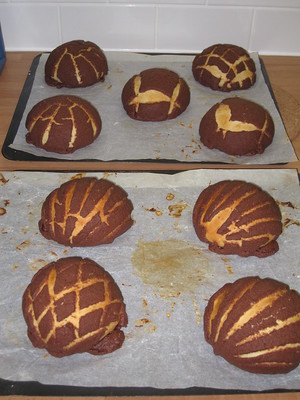The Ultimate Chilli Con Carne from DinnerDiary has been on my to cook list for ages and following a recent blogpost there, I decided that it's now high time for it.
Ingredients
2 tbsp olive oil
3 red Thai chillies
6 cloves of garlic
2 cans of beans (400 g each)
400 g can tomatoes
1 green bell pepper
2 tbsp olive oil
500 g lean minced beef
salt and pepper
2 tbsp olive oil
1 large onion
2 tsp ground cumin
1 tsp ground coriander
1 tsp hot chilli powder
1 tsp ground cinnamon
1 tsp smoked paprika
2 dl red wine
300 ml beef stock
2 tbsp tomato puree
1 bay leaf
1 tsp cocoa powder
Method
- Preheat the oven to 190 degrees. Then wash the chillies and remove the flimsier paper bits off the garlic and place in a small ramekin. Then drizzle 2 tbsp of olive oil, cover with aluminium foil and bake for 30 minutes, then allow to cool.
- Prepare the beans by draining them and the tomatoes by crushing or even liquidising them. Wash and cut the pepper into small pieces.
- In a large lidded non-stick pan, heat up 2 tbsp olive oil, season and brown the meat, then set it aside.
- Heat up another 2 tbsp olive oil and soften the onions. In the mean time, deseed the chillies, peel the garlic and mush up with the oil they roasted in.
- Add the chilli/garlic to the onions and fry through for a couple of minutes, then do the same with the ground spices.
- Deglaze with the wine, then add the browned mince, beef stock, tomatoes, tomato puree and beans. Some further seasoning may also be called for.
- After all has come to boil, put a lid on and reduce the heat to low, then let simmer for an hour.
- Add the green bell pepper and the cocoa powder and let simmer for another 20 minutes.
Unfortunately living outside of London means I can't get hold of all different types of chillies and I also had some cans of beans I wanted to use up, so as usual I'm improvising a bit. The biggest thing is that I halved the stock, since I don't have beans that require cooking and will soak up a substantial amount of the liquid. Still the chilli was more of a thick soup than a stew when I put the lid on.
So I took the lid off and hoped that most of the liquid would evaporate during cooking. And indeed after 32 minutes I had a lovely looking stew, so I put the lid back on and moved the pan to a small burner on its lowest setting. it smelt wonderfully too, the smoked paprika dominated, with a delayed but distinct hint of sweet cinnamon. Later on in the cooking, the cinnamon took over almost completely.
Doing things on the day before will of course allow flavours to develop. And cooking slowly for longer too, but mainly it is important in order to get the beans cooked through. The time can be reduced when using canned beans, though I'm sure they would change the overall flavour. The Thai chillies turned out to heat up the chilli con carne very nicely indeed - which was a nice surprise, usually we struggle to get it hot enough for our taste. Also I was very excited about the cocoa powder. I've encountered chocolate in game pies and I know on the whole it adds to the richness, but I've never been brave enough to use it myself.
Overall, this was a success, the chilli was very much different from what we normally do, which is an adaptation of Delia Smith's simple recipe. No specific spice or ingredient dominated or even came forward, but instead they all blended to a very rich flavour, though perhaps a bit on the sweet side.
Still the above worked very nicely indeed and we had it with tortillas, nachos, tomato salsa, sour cream and what claimed to be guacamole. The last two helped mellow the heat of the Thai chillies.
The "guacamole" is a very old recipe, one of the first I picked up when I started collecting recipes and I've been meaning to try out for a very long time. Old recipe as in 1988 or 1989 I can't remember exactly. It was one of those info leaflets about new and exotic foods that were beginning to appear on the Swedish market and was to encourage people to give it a try. Actually I think most people were already familiar with avocados, but it wasn't perhaps as popular as it is nowadays. I've no idea who issued this leaflet and what I ended up with is certainly not guacamole as it is known in the UK today, but the mixture was rather tasty anyway.
Ingredients
3 large ripe avocados
1 small onion
1.5 dl sour cream
1 large clove of garlic
salt and pepper
a few drops of Tabasco
1 medium hot fresh red chilli
Method
- Cut the avocados in half, remove the stone, then scoop out the flesh with a spoon onto a bowl.
- With a fork, mush up the avocado - the idea is to still have a few chunks for texture.
- Peel and finely dice the onion, then add to the avocado along with the sour cream.
- Press in the garlic, season and add the Tabasco.
- Wash and if needed deseed the chilli, then chop it finely and add to the mixture.
- Stir in everything well, then chill until needed.
I think this recipe could benefit from dill and possibly swap the onion for red onion or chives to get a more interesting colour as opposed to washed out green. The mixture would work well just as a regular dip and I suspect might be quite nice in a sandwich cake too.






